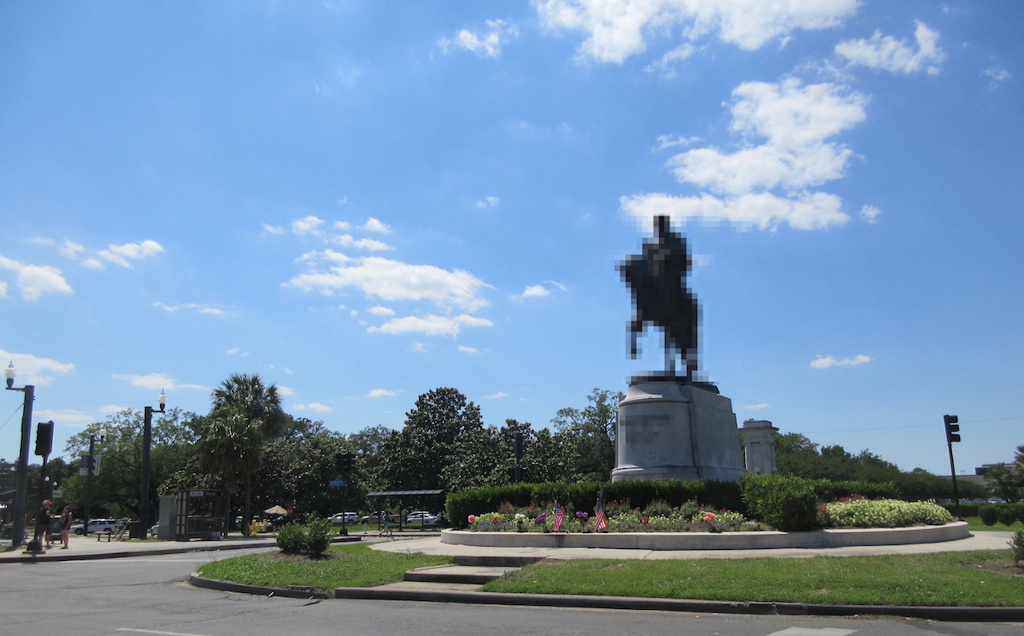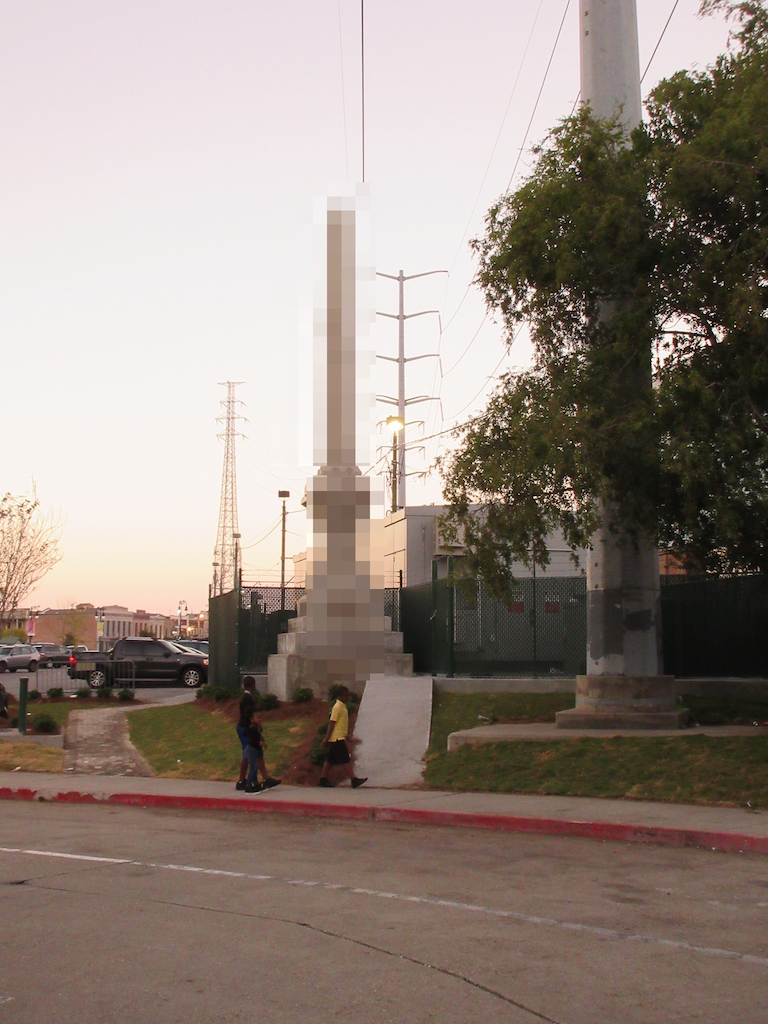The Old Monuments
Watching the Confederate statues come down in New Orleans.

Most evenings after six or so, the crowds in front of New Orleans’ Confederate monuments settle into a lull. Sometimes it’s six or seven stragglers. Sometimes it’s a couple and their dog. They bring wrinkled Confederate flags, and Mississippi bandannas, and sometimes a handful of American ones too, and since Louisiana is open-carry they’ll flash the pistol on their belt, posted up and shouting at random passersby into the night. A lot of these folks are local, but a good chunk of them aren’t. Nobody seems to know what to do with them. Mostly they’re left alone.
The first monument was erected in the late 19th century. There’s one of Robert E. Lee, and one of General P.G.T. Beauregard, but the Jefferson Davis and Battle of Liberty Place monuments are gone. Police escorts assisted with their removal in the middle of the night. The first round took place on April 24th, and the second happened after midnight on May 10th, and the city isn’t saying when the rest will follow. They swear it’ll be sooner than later.

The campaign to bring them down picked up steam in late 2015. Mayor Mitch Landrieu deemed the statues as public nuisances. He signed an ordinance calling for their removal. But the first company that came forward to assist with that was deluged with death threats, and then the next one afterwards, and then the next one after that, and then, for a while, it looked like they actually weren’t going anywhere after all.
Last month’s first after-hours removal was a jolt and a shock. Before the Liberty Place structure came down, some protestors held a candlelight vigil. They really looked like they were mourning. A couple held actual candles. But most of them were fucking around on their phones. And that insistence on the preservation of bigotry might sound consolidated and condensed, but New Orleans is actually steeped in it; it’s interpreted as a jutting branch of Southern romanticism.
Of course you’ve got the Deep South factor, but the dog whistles are blasting all over the city; in fact, a few years back, Dillard University literally hosted David Duke on its grounds for a Senate debate. But about a week ago, I was biking through Mid-City, where the Davis monument loomed, when I nearly collided with this white lady riding one of those babyseat-bicycles. We both stopped and apologized. Her kid sort of wagged his hands at me. We rode for another two minutes in silence before we ended up in front of a protestor.
He wore an over-large “Don’t Mess with Texas!!!” hat. He had those flags with the snake in each hand. He looked totally, wholly prideful, absolutely lost in his cause — and, for the briefest of moments, I actually tried to have a slither of empathy. But then the lady in front of me cleared her throat, and she spat on the grass beside him.
You need to go the fuck back home, she said. Her kid and I made the same face.
You are not from here, said the mother, and you need to go the fuck back home.

Since the city isn’t telling us when they’re bringing the next statue down, the consensus seems to be that it could happen any night. So depending on which of the remaining monuments you show up to, and when you show up, you might find a modest crowd of squatters policing the grass just beside them.
One afternoon around Jazz Fest, a small tussle enveloped the Beauregard monument. Observing from the outside, the group looked mostly white, but there were a handful of Latino people, and one or two Asian folks in the thick of things. I didn’t see any black bodies in the mass — they were standing on the periphery. Almost instantaneously, the cops started converging, and the group damn near dissolved entirely.
The people left started to shift, looking more than a little antsy. The deep looks we’d been giving each other turned into something a little closer to kinship. One white lady I talked to said she was out here for support. She was in town from California. One white guy said he was out here because it he felt like it was his duty, and the white guy beside him, probably his buddy, said it was the least that they could do. Two black women stood by the streetcar, a younger lady and someone who looked like her mother, and when I asked what she was doing she looked at me through her shades, and then what she did was laugh. She said she was only watching.
Another afternoon, a few days later, around the same monument, I ended up staring at it next to this older white guy. We ignored each other for a while, and then he sort of looked me up and down. Eventually, he told me that he was a local. He was hoping the mayor would come to his senses and leave the statues alone. He said told me that the monuments were history, that the city was destroying history, and we all knew what happened when you forget the things that you’ve done. He asked how I felt about the other statues, ticking them off one by one, and did I know that each of those individuals was integral to New Orleans, that they were regal institutions. He asked me if I thought that history was worth preserving. He asked how I felt about each of those statues.
A month earlier, I’d been invited to the Beauregard-Keyes House, which is a sterling, glossy residence, square in the French Quarter. After a couple hours’ worth of drinks, more than one acquaintance made it a point to tell me that the General was “a good Confederate.” He was compassionate, they said. He cared about black people. I nodded and smiled and fought the urge to piss all over their floor.
I told the guy standing beside me that the statues were pretty shitty. He looked disappointed in me. The conversation was over.
For a little while, we watched a group of protesters shout each other down. One guy was bearded, big and tall, and the others were an Asian couple in vacation garb. The two men toed the line towards one another, but neither of them did anything physical. They looked a little like a parabola, getting just close enough for something to happen.

This past weekend, there was a rally championing the dissolution of these monuments, and hundreds of people showed up. The march started in the Quarter, before snaking downtown, until it ended up in front of the structure by Lee circle. The photos were all over my feed. I saw pictures of reunions taking place, and pictures of signs that had been made. Every other person was smiling. It looked like something had been accomplished.
And then, three days later, it was. Around eleven on Wednesday night, my phone let me know that the elementary schools surrounding the Davis monument had been put on notice. The next one was coming down. It didn’t take long for the crowds to develop. They started small, until they weren’t anymore, and every now and then the cops stepped in to separate the clusters. When the statue was finally lifted, there boos and cheers and boos. Friends posted selfies with the monument in the background, behind backdrops of oversized Confederate and flags. A few banners streams in the foreground, claiming they’d make the country great again.
The next morning, a buddy texted me to ask what had changed. The statue’s gone, he said, but there’s always something else. And if you’re driving down Jefferson Davis Parkway, the monument’s gone, but that platform’s still there, right along with the ground on which it stood.

There’s been a lot of talk that it’s New Orleans’ commitment to diversity that’s bringing these statues down. And that could very well be true. But the white supremacy’s still there. It’s deeply ingrained in the city’s foundation, in its draconian incarceration policies and its segregated housing and a commitment to commodifying who gets what quality of education. New Orleans has a lot of different people, from a number of different places, but it would suck if that diversity overshadowed the fact that it’s a majority black city. And in this majority black city, the black people are being priced out. The black people aren’t given loans. The black people are cordoned to the outskirts of the affluence. The black people are subject to food deserts, and the black people are jailed at astronomical rates; but now, the black people won’t have to drive past statues of white men embodying a time when black people weren’t considered people at all.
Once the final statue’s carted off, black people will continue being treated like black people in New Orleans. There will still be poor people when the statues come down. Families will continue to be priced out when the statues come down. Even still, that’ll keep happening, the structural change that’s needed still isn’t forthcoming, and it will do us good not to hold our breath until it does.
But, for now, the statues are coming down. We’re really going to do it. We might be sleeping when they go, but in the morning they’ll be gone.
